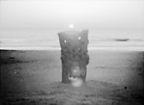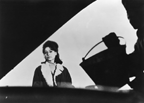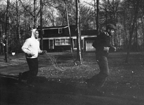In Honor of Teshigahara Hiroshi
Source: Teshigahara Productions

All of the activities Teshigahara Hiroshi embarked upon throughout his life were characterized by a relentless pursuit of creative dynamism. For Teshigahara, a creator and a producer who left behind an impressive legacy in post-war Japanese avant-garde art, artistic creation was indubitably an act in which an artist uses dramatic dynamism to create beauty, and art with new value was born most definitely from the intersection of different artistic movements. When Teshigahara discovered film while studying painting at university, he must have found it an extremely attractive medium with which to amalgamate a range of artistic genres, make images and concepts concrete and construct them dynamically as expression.
Teshigahara studied under Kamei Fumio and demonstrated his belief that documentary is a subjective creation by its director in his short film Jose Torres (1959). His subsequent documentaries and dramatic features have been stripped of all trace of the emotion and lyricism that could have accompanied the creation of such dramatically-composed works from the clearly-defined perspective of the filmmaker. The filmmaker uses his aesthetic sense to pick out fragments of reality, the recombination of which transforms abstract concepts into images. These unique qualities of Teshigahara’s filmmaking polish his subjects’ beauty further without making any concessions to commercialism, thanks perhaps in part to Teshigahara’s position as the head of the Sogetsu school of Japanese flower arrangement. Endowed with both a gift and the environment in which to express it, Teshigahara was in a sense a fortunate, pure-cultured successor to postwar avant-garde art.
—Suzuki Akihiro
|
Teshigahara Hiroshi
Born in Tokyo in 1927, the eldest son of Teshigahara Sofu, founder of the Sogetsu school of flower arrangement. Graduated from the Tokyo Fine Arts School (now the Tokyo National University of Fine Arts and Music) in 1950. After making his first venture into the world of films about art with Hokusai (1953), worked on Kamei Fumio’s films. In the late 1950s formed the “Cinema 58” group with Matsuyama Zenzo, Hani Susumu, and others, and made the group production Tokyo 1958 in 1958. Made first full-length dramatic feature The Pitfall in 1962, followed by The Woman in the Dunes (1964), The Face of Another (1966) and The Man without a Map (1968), all from screenplays by Abe Kobo. Summer Soldiers (1972) was followed by a brief lull, but Teshigahara returned to fimmaking in the 1980s, directing the feature-length documentary Antonio Gaudi (1984) and the dramatic feature Rikyu (1989). Teshigahara was also the chief juror at the inaugural YIDFF in 1989. Basara—The Princess Goh was released in 1992. Passed away in April 2001. |
Tokyo 1958
 JAPAN / 1958 / French, English, Japanese / Color, B&W / 16mm / 30 min
JAPAN / 1958 / French, English, Japanese / Color, B&W / 16mm / 30 min
Directors, Script, Planning: Teshigahara Hiroshi, Hani Susumu, Matsuyama Zenzo, Kusakabe Kyushiro, Ogi Masahiro, Kawazu Yoshiro, Maruo Sadamu, Mushanokoji Kanzaburo, Sakisaka Ryuichiro
Photography: Kikuchi Shu, Segawa Hiroshi, Fujii Yoshitaka
Music: Hara Hiroo
Production: Cinema 58
This experimental film was entered in the World Experimental Film Competition held in Brussels, Belgium, and is the work of “Cinema 58,” a nine-strong experimental filmmaking group including Teshigahara Hiroshi, Matsuyama Zenzo, Hani Susumu, and Kawazu Yoshiro as well as film critics Ogi Masahiro, Kusakabe Kyushiro and Maruo Sadamu. The group took the unique approach of sharing screenwriting, direction and editing amongst all members, giving us snapshots of daily life within the themes of Tokyo chaos and traditional Japan, while drawing on ukiyo-e woodblock prints.
Sculptures by Sofu—Vita
 JAPAN / 1962 / No dialogue / B&W / 16mm / 11 min
JAPAN / 1962 / No dialogue / B&W / 16mm / 11 min
Director: Teshigahara Hiroshi
Photography: Segawa Hiroshi
Editing: Shuzui Fusako
Music: Ichiyanagi Toshi
Lighting: Kume Mitsuo
This unique art film is composed of a layers of avant-garde images of uniquely-formed sculptures, and sound effects. The sculptures are the work of Teshigahara Sofu, the founder of the Sogetsu school of flower arrangement and the director’s father. The sculptures, displayed in a room, are juxtaposed against such natural scenery as forests and the sea, and an abstract movement of images is achieved by the techniques of overlapping, shooting frame-by-frame and close-ups. Sculptures by Sofu—Vita attempts to reconstruct the pulsating life that resides within static sculptures through the medium of film.
AKO—White Morning
 JAPAN / 1965 / Japanese / B&W / 35mm / 29 min
JAPAN / 1965 / Japanese / B&W / 35mm / 29 min
Director: Teshigahara Hiroshi
Original story, Script: Abe Kobo
Photography: Ishimoto Yasuhiro
Music: Takemitsu Toru
Producer: Wakatsuki Shigeru
Cast: Irie Miki, Hasegawa Teruko, Matsushita Yoko
Production Company: Ninjin Club
Adapted for film by Abe Kobo from one of his own works, AKO—White Morning was made as the Japanese component of the omnibus work Fifteen-Year-Old Widows (Japan, Italy, France, Canada.) With Ako, a sixteen-year-old working in a bread factory, as its protagonist, White Morning is a cinema verité-style portrayal of what it was like being young in the sixties. Based around sketches of Ako’s days off spent with her boyfriend, White Morning is a collage of daily work in the factory and young Ako’s comments on her life. A soundtrack by Takemitsu Toru brings the images to life.
Jose Torres Part II
 JAPAN / 1965 / Japanese, English, Spanish / B&W / 35mm / 54 min
JAPAN / 1965 / Japanese, English, Spanish / B&W / 35mm / 54 min
Director: Teshigahara Hiroshi
Photography: Marvin E. Newman
Editor: Shuzui Fusako
Sound: Okuyama Junosuke
Music: Takemitsu Toru
Narrator: Akutagawa Hiroshi
Producer: Aoyagi Tetsu
Production Company: Teshigahara Productions
This is the sequel to Jose Torres (1959), the portrayal of Puerto Rican boxer Jose Torres, who won a silver medal in the 1956 Melbourne Olympics. We follow Torres from his training in preparation to challenge world lightweight champion Willie Pastrano, to the match and Torres’ victory in 1965. The contrast between the nervous Torres before the match, filmed in painstaking detail, and the first round, filmed in one shot, is striking.
